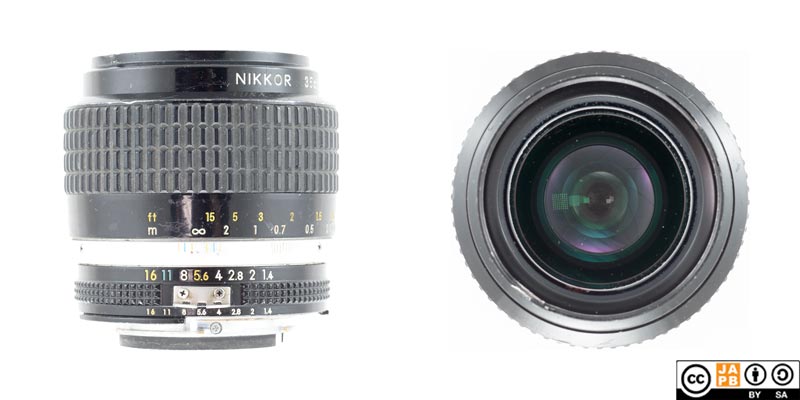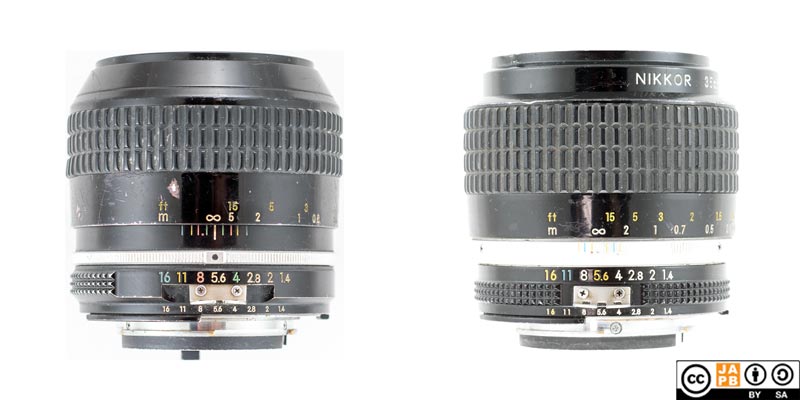Pekka Buttler, 01/2024

Specifications
The table below summarizes the lens’ key specifications (measurements based on pictured sample):
| Brand: | Nikon (Nikkor) | Lens name | 35 mm 1:1.4 |
| Focal length(s) 1 | 35 mm | Angle-of-view 2 | 62° |
| Maximum Aperture | f/1.4 | In Production | 1981–2020 |
| Lens mount | Nikon F | Subfamily (if applicable) | Ai-s |
| Length 3 | 62,0 mm | Diameter 4 | 67,7 mm |
| Filter ring diameter | 52 mm | Weight | 389 grams |
| Lens element count | 9 | Lens group count | 7 |
| Aperture blades (S/R/C) 5 | 9 S | Focus throw | 105 ° |
| Minimum focusing distance | 30 cms | Maximum magnification | 1:5,5 |
| Has manual aperture ring | YES | Has Manual focus ring | YES |
| Aperture Mechanism Type | Automatic | Aperture click stops 6 | 1.4-2-2.8-4-5.6-8-11-16 |
Further notes:
• Users should be warned that the frontmost (central) part of the front element is barely behind the filter ring, and that some aftermarket lens caps actually touch the front of the first lens element. If ever there was a candidate for using a protective filter, this lens has to be at the top of the list.
• This lens was kept in production all the way to 2020, which has to be seen as a testament to the quality of the lens.
• The custom lens hood Nikon offered for this lens goes under the name HN-3 (the HN-3 is the lens hood used on every manual-era Nikkor 35 mm lens, with the exception of the series E 35 mm).
A brief genealogy of Nikon SLR lens types
Nikon is undoubtedly one of the great names in 35 mm SLR photography. The Nikon F mount has been in continuous production since 1959. During that time, the mount has developed/changed in some detail, however without ever fully sacrificing compatibility.
In short (a longer version is here), the development of Nikon’s SLR lenses can be traced as follows:
• 1959–1977: Pre-Ai. Manual focus lenses that use ‘rabbit ears’ to communicate selected aperture with the camera body.
• 1977–1986: Ai and Ai-s. Manual focus lenses that may have ‘rabbit ears’ for backward compatibility, but are primarily designed to communicate selected aperture with the camera body through indentations in base of aperture control ring.
• 1986–today: AF and AF-D. Autofocus lenses that do not have a focusing motor within the lens, but rely on the focus motor within the camera. All AF and AF-D lenses are simultaneously Ai-s lenses (they are Ai-s lenses extended with AF) 7
• 1996–today AF-S and AF-P. Autofocus lenses that have an internal focusing motor and do not rely on the body having a focusing motor.
Nikon was the first manufacturer to manage to produce a 35 mm focal length SLR lens with a maximum aperture of f/1.4 (see details of development on Nikon’s site) in 1970, and this combination remained rare throughout the manual era (in fact, only Nikon, Zeiss, and Leica really8 offered 35/1.4 SLR lenses).
Versions
During its entire history, Nikon has produced five different 35 mm f/1.4 lenses. All but the last are purely manual focus lenses:
| Generation | Years | Design | Blades | Focus ring | notes… |
| C-type (Nikkor N•C 35 mm f/1.4) | 1970–76 | 9 elements, 7 groups | 7 or 9 | metal | radioactive |
| K-type (Nikkor 35 mm f/1.4) | 1975-77 | 9 elements, 7 groups | 7 | rubber | not radioactive |
| Ai-type (Nikkor 35 mm f/1.4) [data sheet] | 1977–81 | 9 elements, 7 groups | 7 | rubber | not radioactive |
| Ai-s type (Nikkor 35 mm f/1.4) [this lens] | 1981-2005 | 9 elements, 7 groups | 9 | rubber | not radioactive |
| AF-S (Nikkor AF-S 35 mm f/1.4 G) | 2010– | 10 elements, 7 groups | 9 (rounded) | rubber | not radioactive, has AF |
While there was a significant redesign to get rid of the needing to uses a thoriated element (going from the C-type to the K-type), the optical recipe of this 50-year family of lenses remained surprisingly unchanged until the introduction of the AF-S version. Obviously coatings developed further, lens machining methods improved, but the original, 1970 design showed tremendous staying power.
Differences between the Ai and Ai-s design
In 1981 Nikon upgraded almost its entire lens lineup from Ai to Ai-s. While the primary reason was to calibrate the aperture mechanism of the lenses in such a way as that the body could close down the lens’ aperture to a specific diameter in order to enable shutter priority and full auto exposure, Nikon used the opportunity to implement some more changes, the most typical of which was to shorten the focus throw of the lenses – a change that was met with considerable skepticism as many felt that it made manual focusing too much more difficult. However, with some exceptions, Nikon made no changes to the optical recipes in going from Ai to Ai-s.
In the case of the 35/1.4 the full list of modifications was:
– 9 aperture blades instead of 7
– A shortening of the focus throw from 180 ° to 105 °
– a minor redesign of the lens’ housing (see image below)

Right: Nikkor Ai-s 35/ mm f/1.4
Adapting
Besides adapting, this lens can be used natively on all current high-end Nikon dSLRs and several earlier medium-to-high-end older Nikon dSLRs9. Likewise, if it still has its rabbit ears, it can be natively used on all Nikon F-mount film cameras ever produced (without the rabbit ears, it is limited to post 1977 bodies).
Thanks to being a fully manual lens (manual aperture, manual focus), the lens can be adapted to all mirrorless cameras using a suitable dumb adapter (and such adapters are easy to find). Moreover, a large range of special adapters (helicoid adapters, tilt/shift adapters, speed boosters) for using Nikon F lenses on most mirrorless systems are available.
Using Nikon F lenses on non-Nikon SLRs and dSLRs is likewise a distinct possibility. Thanks to the relatively generous flange focal distance of the Nikon F mount (46,5 mm), adapter rings for all dSLR mounts are available as well as for a goodly portion of film-era SLR mounts. Such rings may not allow for auto aperture, but even then the lenses can be used in stop-down metering mode.
Footnotes
- Focal length is (unless stated otherwise) given in absolute terms, and not in Full-frame equivalent. For an understanding of whether the lens is wide/tele, see ‘Angle-of-view’. ↩︎
- Picture angle is given in degrees and concerns the diagonal picture angle. Rule of thumb:
> 90 ° ==> Ultra-wide-angle
70–90 ° ==> Wide-angle
50–70 ° ==> Moderate wide-angle
40–50 ° ==> ‘Standard’ or ‘normal’ lens
20–40 ° ==> Short tele lens
10-20 ° ==> Tele lens
5-10 ° ==> Long tele lens
< 5 ° ==> Ultra-tele lens ↩︎ - Length is given from the mount flange to the front of lens at infinity. ↩︎
- Diameter excludes protrusions such as rabbit ears or stop-down levers. ↩︎
- S=straight; R=rounded; C=(almost)circular at all apertures. ↩︎
- Numbers equal aperture values on aperture ring; • intermediate click; – no intermediate click. ↩︎
- There is a further sub-class of AF-D lenses called AF-I lenses that are otherwise AF-D lenses (meaning, fully Ai-s compatible), but have an internal focus motor. Only long tele lenses were made in AF-I variants. ↩︎
- Focusing on the pre-AF age, besides Nikon (for Nikon F), Zeiss (for Contax/Yashica), and Leica (for Leica R), there are only unicorns – lenses that, while certainly documented, are so rare that they might for all practical purposes not exist. Such are for instance the Soviet Mir-46 (1980).
After the introduction of AF photography, also Canon and Minolta offered their own products, and since the end of the naughties several more contenders have entered this space, most notably Sigma and Samyang/Rokinon (also rebranded as Walimex/Polar/Vivitar/) ↩︎ - As of this writing, the following Nikon dSLRs fully support Aperture priority and manual metered modes on Nikkor Ai lenses: D2, D3, D4, D5, D6, D200, D300, D300s, D500, D600, D610, D700, D750, D780, D800, D800E, D810, D850, D7000, D7100, D7200 ↩︎